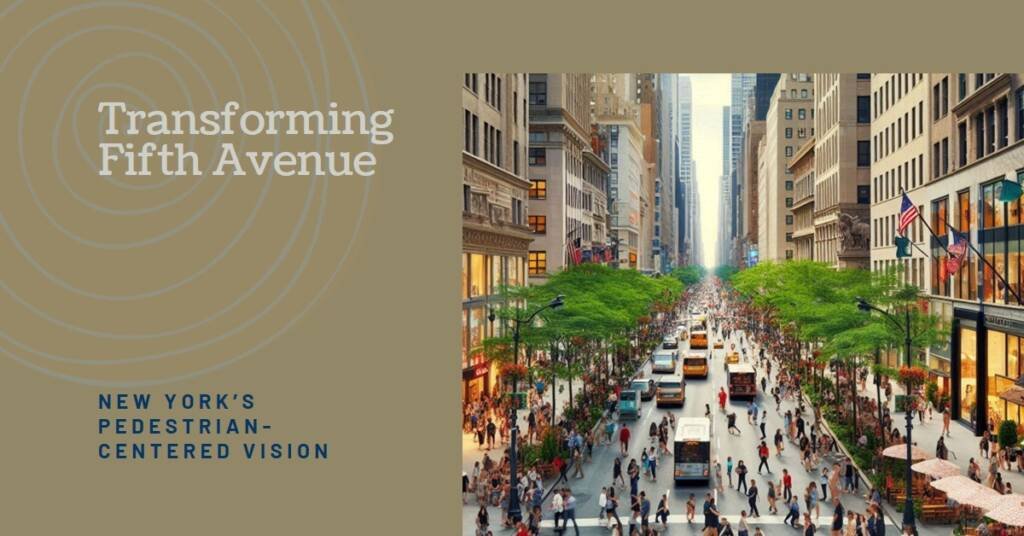
Table of Contents
- Introduction to Fifth Avenue Transformation
- Historical Context of Fifth Avenue
- Key Features of the New Design
- Community Involvement and Feedback
- Environmental and Health Benefits
- Economic Implications of the Transformation
- Challenges and Criticism of the Vision
- Upcoming Steps and Timeline
- Conclusion: A New Era for Fifth Avenue
Introduction to Fifth Avenue Transformation
The transformation of Fifth Avenue into a pedestrian-centered zone represents a significant initiative aimed at enhancing urban walkability and creating a more vibrant city atmosphere. This bold project arises from the growing recognition of the need for urban environments that prioritize pedestrians over vehicles, reflecting broader trends in urban design where walkability is increasingly considered essential for a sustainable city. The motivations behind this transformation are rooted in various factors, including increased foot traffic, improved public health, and heightened economic activity.
Fifth Avenue, known for its iconic skyline and cultural landmarks, serves as a critical artery in New York City. However, the heavy flow of vehicular traffic often detracts from the overall experience for pedestrians. By implementing design strategies that favor walking, the initiative aims to reduce congestion, lower pollution levels, and create safe spaces for pedestrians. This shift encourages not only local residents but also tourists to explore the area more freely, thereby directly benefiting local businesses.
Desired outcomes of this transformation include increased accessibility for all individuals, regardless of their mobility limitations, and enhanced public safety through the implementation of pedestrian zones and traffic calming measures. Additionally, the project seeks to foster community engagement by creating gathering spaces that can host events and cultural activities, thereby enriching the urban fabric. Emphasizing walkability promotes a sense of community, encourages social interaction, and nurtures a more inclusive environment for New Yorkers and visitors alike.
In summation, the transformation of Fifth Avenue underscores the significance of creating pedestrian-friendly urban landscapes. By prioritizing the needs of pedestrians, this project not only aims to revitalize Fifth Avenue but also serves as a model for urban planners globally, illustrating the benefits of walkable cities. As we continue to confront challenges such as climate change and urban congestion, projects like this will undoubtedly play a crucial role in shaping the future of our urban spaces.
Historical Context of Fifth Avenue
Fifth Avenue has long been recognized as one of New York City’s most iconic streets, serving as a vital artery of commerce, culture, and social life. Beginning in the mid-19th century, this thoroughfare emerged as a primary location for the affluent, reflected in the grand architecture and elaborate townhouses that lined its length. The construction of the Metropolitan Museum of Art in 1880 marked a significant cultural milestone, firmly establishing Fifth Avenue as a center for art and education. Over the decades, other notable institutions, such as the New York Public Library and the Guggenheim Museum, shaped the avenue into a cultural nexus, attracting both locals and tourists alike.
From a purely commercial perspective, Fifth Avenue began to transform in the late 19th and early 20th centuries. Retail giants such as Saks Fifth Avenue and Bergdorf Goodman set the standard for luxury shopping, creating an allure that has continued to draw shoppers from around the globe. The street’s development parallels broader economic changes in the United States, particularly following the construction of the subway system, which increased accessibility and stimulated commercial growth. This bustling environment contributed to Fifth Avenue’s reputation as “The Avenue” for the wealthy and the elite, making it a symbol of American prosperity.
The historical evolution of Fifth Avenue did not occur in a vacuum; it mirrored societal shifts, including those towards greater accessibility and inclusivity. As the 20th century progressed, various movements aimed to reclaim urban spaces for pedestrians, leading to significant public initiatives that transformed previously vehicular-dominated roadways into inviting pedestrian zones. Such transformations are crucial as New Yorkers now envision a future where Fifth Avenue can emerge as a paradigm of pedestrian-centered development, ensuring that this historic thoroughfare remains relevant and vibrant for generations to come.
Key Features of the New Design
The proposed design for transforming Fifth Avenue in New York City includes several key features aimed at enhancing pedestrian experience while promoting urban livability. One of the most significant elements is the expansion of sidewalks, which will provide more space for pedestrians, ultimately allowing for a safer and more comfortable strolling environment. Wider sidewalks are particularly crucial in high-traffic areas, as they facilitate improved flow and reduce the congestion often experienced by walkers navigating narrow passages.
In addition to expanded sidewalks, the design incorporates dedicated bike lanes. These lanes will not only enhance safety for cyclists but also encourage more individuals to adopt biking as a practical mode of transportation. By separating bike traffic from pedestrians and vehicles, the design aims to create a harmonious coexistence of all road users, thereby boosting overall urban mobility.
Green spaces are yet another integral feature of the transformation plan. The inclusion of parks and landscaped areas along Fifth Avenue will provide much-needed breathing room in an otherwise bustling urban environment. These green spaces will not only improve air quality but also serve as recreational spots where people can relax, socialize, and engage in various activities. The addition of trees and plants contributes to a more aesthetically pleasing atmosphere, which can enhance the psychological well-being of residents and visitors alike.
To further promote the pedestrian-centered vision, the design introduces various public amenities, such as seating areas, water fountains, and informational kiosks. These elements are designed to enrich the experience of individuals traversing Fifth Avenue, making the area more inviting and accessible. Such features ensure that New York City remains a vibrant hub with a focus on community, sustainability, and enhanced livability.
Community Involvement and Feedback
The revitalization of Fifth Avenue has been a community-centered initiative, emphasizing the importance of local engagement throughout the planning and design processes. Recognizing that the best ideas often come from the residents and stakeholders who experience the area daily, city officials and planners have actively sought input to shape the vision for this iconic thoroughfare. Community involvement initiatives included town hall meetings, surveys, and interactive workshops that encouraged diverse participation. Through these channels, residents, business owners, and other stakeholders were able to express their views, ideas, and concerns regarding the transformation of Fifth Avenue.
Feedback collection efforts were pivotal in understanding the community’s priorities. Residents voiced their desire for increased pedestrian-friendly spaces, enhanced safety measures, and improved accessibility. This grassroots input was not only a means to gather opinions but also fostered a sense of ownership over the project, encouraging local pride and responsibility towards Fifth Avenue’s future. The planners often noted that the contributions from community members led to the identification of key design elements, such as wider sidewalks, the creation of green spaces, and dedicated cycling paths.
The role of local businesses also emerged as a significant component of the feedback process. Many business owners expressed their hopes for pedestrian traffic to increase with the new changes and shared suggestions that could balance both economic vitality and urban design. The collaborative efforts between city officials and the community resulted in a design that reflects the collective aspirations of those who live and work along Fifth Avenue. By prioritizing community involvement, the project has become a model for urban development, demonstrating how public input can lead to successful and well-received city transformations.
Environmental and Health Benefits
The transformation of Fifth Avenue into a pedestrian-centered thoroughfare holds significant environmental and health benefits. One of the foremost advantages is the reduction in carbon emissions. By prioritizing pedestrian access and limiting vehicular traffic, the initiative is poised to lead to fewer cars on the road, resulting in decreased greenhouse gas emissions. This shift is critical in the context of global climate challenges, as urban centers like New York contribute a notable portion of overall emissions. Consequently, a pedestrian-focused Fifth Avenue can play an influential role in the city’s commitment to sustainability and combating climate change.
Additionally, with fewer vehicles on the streets, noise pollution is expected to diminish significantly. The constant hum of traffic can adversely affect the quality of life for city residents and visitors alike. Reduced noise levels not only enhance the pedestrian experience but also create a more serene environment that can positively impact mental health and wellbeing. A quieter, more tranquil Fifth Avenue could encourage social interactions and cultural activities, further enriching the urban landscape.
Improved air quality is another critical outcome of this transformation. Recent studies have shown a clear correlation between increased pedestrian areas and enhanced atmospheric conditions. By facilitating more walking and reducing reliance on cars, emissions from fuel combustion are minimized, leading to cleaner air. For city dwellers, who are often subject to higher pollution levels, this initiative stands to improve respiratory health and overall quality of life.
Moreover, the introduction of green spaces along Fifth Avenue could further bolster health benefits. These areas not only provide aesthetic appeal but also encourage physical activity. Increased access to parks and green areas promotes walking, running, and recreational activities, thereby assisting in combating the sedentary lifestyle prevalent in urban environments. Such changes are essential for fostering healthier communities and ensuring that residents can thrive in their city.
Economic Implications of the Transformation
The transformation of Fifth Avenue into a pedestrian-centered area is poised to bring substantial economic implications, shaping the local businesses and the broader economy of New York City. As the city embraces this vision, an anticipated increase in foot traffic is likely to become a significant catalyst for growth in the area. Enhanced walkability and accessibility could attract both tourists and locals, creating an environment conducive to increased consumer spending. Local retail shops and restaurants may experience a boost in business due to greater visibility and accessibility, further stimulating economic activity.
Moreover, the changes to Fifth Avenue could lead to an appreciation of surrounding property values. As the appeal of pedestrian-friendly zones continues to grow, prime real estate situated near these developments may command higher prices. This increase in property values may provide current property owners with a windfall, while also driving new investments into the area. Consequently, this influx of capital may enhance the overall economic landscape, providing opportunities for urban development and improvement.
However, this transformation raises valid concerns regarding zoning and commercialization. With the prospect of increased commercial opportunities comes the risk of over-commercialization of the area. Residents and community advocates may worry that the character and identity of Fifth Avenue could be compromised in favor of high-end retail and chain establishments. Balancing the needs of local businesses with the demands of larger commercial interests must be a key consideration in the transformation process. Sustainable practices and mindful development strategies can help mitigate these challenges, ensuring that local voices are heard and respected.
In summary, the economic implications of transforming Fifth Avenue are multifaceted, with potential for both positive outcomes and significant challenges. The strategic integration of pedestrian-oriented policies may drive growth and revitalization in this iconic corridor, provided that careful attention is paid to the preservation of its unique character and community needs.
Challenges and Criticism of the Vision
The pedestrian-centered vision for Fifth Avenue, while promising significant improvements to the urban landscape, is not without its challenges and criticisms. One of the foremost concerns is the potential for increased traffic congestion. As Fifth Avenue transitions into a more pedestrian-friendly environment, there are fears that vehicle accessibility will be hindered, leading to bottlenecks and delays for motorists. These potential traffic issues raise questions about the efficiency of navigating one of New York City’s busiest thoroughfares.
Additionally, the new vision may adversely affect delivery and transportation services. Many businesses rely on timely deliveries, and adjustments to the street layout could complicate logistics for both large trucks and smaller delivery vehicles. Critics argue that the lack of clear and reliable access points for these vehicles could result in increased operational costs for businesses situated along this famed avenue, ultimately affecting consumer prices. Hence, striking a balance between enhancing pedestrian spaces and ensuring smooth logistics poses a significant challenge.
Moreover, the vision has garnered mixed reactions from community members and stakeholders. While some citizens advocate for a pedestrian-focused Fifth Avenue, others express concerns about the potential displacement of existing businesses and the impact of altering traditional city structures. Property owners may feel that the changes could devalue their assets, while local merchants worry that reduced vehicular traffic could diminish their foot traffic. Community forums have revealed a spectrum of opinions, highlighting the complexity of implementing such a transformative plan within an established urban environment.
In conclusion, addressing these challenges and criticisms effectively will be essential for the successful realization of Fifth Avenue’s pedestrian-centered vision. Engaging stakeholders and considering practical solutions will help navigate the intricate landscape of urban planning in New York City.
Upcoming Steps and Timeline
The transformation of Fifth Avenue into a pedestrian-centric thoroughfare is an ambitious project that emphasizes the need for sustainable urban development. The next stages of this initiative involve careful planning, securing adequate funding, and adhering to a clearly defined timeline to ensure successful implementation. Understanding these steps is crucial for residents and stakeholders who are eager to see positive changes on Fifth Avenue.
Initially, the planning phase will commence with a comprehensive assessment of the current infrastructure, public safety concerns, and community input. City planners and urban designers will engage with local communities to gather feedback and address any concerns that may arise. This phase is expected to take approximately six months, during which various design proposals will be developed, incorporating innovative ideas to enhance pedestrian experiences.
Following the planning stage, securing funding will become a priority. The budget for the project will likely be sourced from multiple avenues, including city capital funds, state grants, and private investments. City officials aim to finalize the budget within the next four months, thereby allowing the project to transition smoothly into the construction phase.
Once funding is secured, construction is expected to begin within a year. The implementation will be carried out in phases to minimize disruption to the public and local businesses. Key milestones will be established to track the progress of the project, which is slated to take about three years for full completion. Residents can anticipate visible changes along Fifth Avenue in the form of new pedestrian pathways, enhanced green spaces, and improved accessibility features each step of the way.
Ultimately, the timeline serves as a crucial roadmap for guiding the execution of this transformative initiative. Residents are encouraged to remain engaged throughout the project’s progression to ensure that Fifth Avenue evolves into a vibrant pedestrian-friendly environment.


Conclusion: A New Era for Fifth Avenue
The recent unveiling of the pedestrian-centered vision for Fifth Avenue marks a significant shift in urban design philosophy for New York City. As the heart of one of the world’s most iconic streets, this initiative highlights the crucial importance of prioritizing pedestrians in vibrant urban environments. The transformation aims not only to enhance the customer experience but also to foster social interactions, promote green spaces, and encourage sustainable transportation. With these objectives, Fifth Avenue could serve as a blueprint for cities grappling with similar challenges in the face of urbanization.
This ambitious vision represents an opportunity to redefine the relationship between commerce and the community. By prioritizing pedestrians, Fifth Avenue will allow for more accessibility and safety, while also creating a more welcoming atmosphere for both residents and tourists. The projected improvements, including expanded sidewalks, dedicated bike lanes, and increased green areas, illustrate how urban planning can evolve to support diverse modes of transportation and promote a healthier lifestyle. Such enhancements can also stimulate local economies by drawing more foot traffic to businesses along the avenue.
Furthermore, as Fifth Avenue sets this precedent, other urban areas in New York City may be inspired to adopt similar pedestrian-friendly designs. The shift toward a more people-centered approach is crucial in addressing the pressing issues of congestion, environmental sustainability, and quality of life in metropolitan settings. This focus on pedestrians could lead to a wave of innovative urban policies that encourage the development of walkable neighborhoods across the city.
In conclusion, as New York embarks on this transformative journey for Fifth Avenue, the emphasis on pedestrian inclusion may herald the dawn of a new era in city planning. The commitment to prioritizing people over vehicles on such a prominent thoroughfare could very well reshape the urban landscape, making it more livable and enjoyable for all residents and visitors alike.



